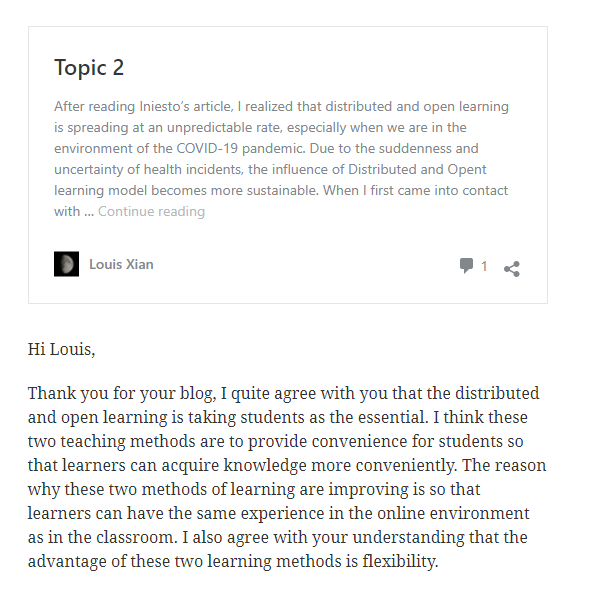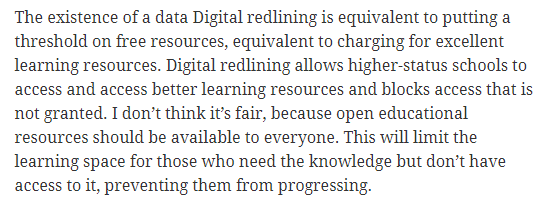Part 1: Evidence and Reflection on Your Learning
1. Describe the potential of human-centered learning in distributed and open learning contexts.
In my topic 2 blog, I analyzed the purpose of improving network learning is to go closer to the real classroom. In this way, students’ learning efficiency can be improved.

As for Ryan’s question, I think a real classroom can provide students with a learning atmosphere and make them feel that they are studying all the time, which will be very efficient.

At the same time, I analyzed the convenience of distributed learning and open learning for specific learners in my pod project.

I also understood human-centered learning through reading other people’s articles.

I think the purpose of distributed learning and open learning is to provide learning convenience for students in different situations so that they can more easily acquire new knowledge. These improvements in learning methods are designed to make learning more efficient, so there is a lot of potentials.
2. Explore and engage with current literature on the distributed and open education movement.
In my topic 2 blog, I discussed the literature on the use of distributed and open education.

In my topic 4 blog, I described the use of OER-Enabled Pedagogy.

I also received approval for my analysis of OER-Enabled Pedagogy.

Through reading this literature and my own understanding and analysis, I have a clear idea of how these distributed and open education should be integrated into face-to-face education. In online learning, distributed and open learning can provide convenience for learners. Integrating open learning into face-to-face teaching can also create a new teaching environment.
3. Critically reflect on and articulate concepts around modality, pedagogy, and access, including distributed and open learning theory, online and open learning history, privacy laws, online learning communities, open research, and open data.
In my topic 1 blog, I talked about the concept of network security. This is what you have to know in online education.

In my topic 3 blog, I discussed some concepts about digital redlining.

Through reading this literature and my own analysis, I think network security is very important for online learning. In online learning, the right of privacy and access is worth the attention of learners and teachers, just like whether the professor’s lecture notes can be shown to others, which involves the ownership of others.
4. Examine and reflect upon the potential for equitable access for all learners in online and open learning contexts.
In my topic 3 updated blog, I talked about equity in online teaching and equity in public teaching resources.
In my pod project, I have tabulated the advantages of various learning methods for particular students.
Through learning, I think there are indeed problems affecting learners’ access to open teaching resources in the Digital redlining, which is very unfair to unqualified learners who need these resources. For some learners who don’t need high access resources, the open learning environment gives them the opportunity to learn the same knowledge as others, which is fair to them. The open learning environment can also provide learning opportunities for more diverse learners. It is fair for most learners to have the same learning opportunities. So open learning has a lot of potentials.
5. Conduct research into and critically reflect upon emerging and future educational technologies.
In my topic 1 blog, I discussed the benefits of blended learning and online learning.
In my topic 4 blog, I described what is the OER-Enabled Pedagogy.
I think these teaching methods have great potential through learning. Blended learning can make face-to-face teaching more efficient, and learners can flexibly review or preview course content on the Internet. OER-Enabled Pedagogy also provides a new environment for students to exchange ideas, but most students have adapted to the traditional learning method. How to make students adapt to OER-Enabled Pedagogy and whether OER-Enabled Pedagogy is the best choice for some students still need to be studied.
Part 2: “Showcase” Blog Post
The original version:
The updated version:
Rationale For Changes:
By learning more about the difference between distributed and open learning, I believe that open learning resources will become distributed learning resources once they are charged. Open learning resources should be available to everyone. In this way, access blocked by data redlines would be unfair. In addition, through the production of the pod project, I found that online learning still has a lot of potentials to promote fair access to resources, so I added this idea of inclusive design.
References:
Regan, P., & Jesse, J. (2019). Ethical challenges of edtech, big data and personalized learning: Twenty-first century student sorting and tracking. Ethics and Information Technology, 21(3), 167-179. DOI: 10.1007/s10676-018-9492-2
Morris, S. M., & Stommel, J. (2018). An urgency of teachers: The work of critical digital pedagogy. Hybrid Pedagogy.
Vaughan, N. D., Garrison, D. R., & Cleveland-Innes, M. (2013). Teaching in blended learning environments: Creating and sustaining communities of inquiry. AU Press.
Jordan, K. & Weller, M. (2017) Openness and Education: A beginners’ guide. Global OER Graduate Network.
Major, Clair Howell. (2015). Teaching Online – A Guide to Theory, Research, and Practice. Johns Hopkins University Press. Retrieved from http://ebookcentral.proquest.com/lib/uvic/detail.action?docID=3318874 (pp. 76-108)
Mays, E. (Ed.). (2017). A guide to making open textbooks with students. Rebus Community.
Gilliard, C., & Culik, H. (2016, May 24). Digital Redlining, Access, and Privacy. Common Sense Education.
Kral, I. & Schwab, R.G. (2012). Chapter 4: Design Principles for Indigenous Learning Spaces. Safe Learning Spaces. Youth, Literacy and New Media in Remote Indigenous Australia. ANU Press. http://doi.org/10.22459/LS.08.2012
Wiley, D. & Hilton, J. (2018). Defining OER-enabled Pedagogy. International Review of Research in Open and Distance Learning, 19(4).